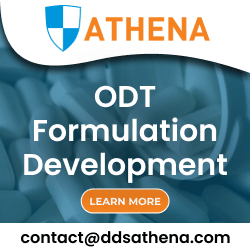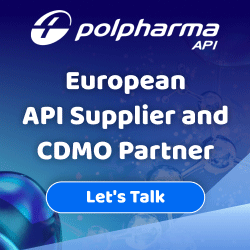Overview of orally disintegrating tablets (ODTs) & more on CDMOs offering formulation development services for oral dispersible solid dosage forms.
Q1. What are orally disintegrating tablets (ODTs) and what are the benefits?
An orally disintegrating tablet (ODT) is a solid dosage form that disintegrates and dissolves in the mouth without water within 60 seconds or less. Orally disintegrating tablets are also called orodispersible tablets, mouth-dissolving tablets, fast disintegrating tablets, quick-dissolving tablets, rapid-disintegrating tablets, porous tablets, fast melts and quick melts.
The oral administration route is considered to be the most widely used route because of its convenience of administration and manufacturing. Over the past three decades, orally disintegrating tablets (ODTs) have gained much attention as a preferred alternative to conventional oral dosage forms such as oral tablets and capsules.
There are many patients for whom traditional oral tablets and capsules are not ideal dosage forms. It is difficult to persuade the pediatric population to swallow them, and they may pose a choking hazard. Adults, for example, bariatric patients and people with Parkinson’s may have trouble swallowing conventional oral dosage forms. Orally disintegrating tablets (ODTs) provide an alternative to overcome these challenges.
New ODT technologies address many pharmaceutical and patient needs, ranging from enhanced life-cycle management to convenient dosing for paediatric, geriatric, psychiatric patients with dysphagia, etc. Various scientific techniques including spray drying, sublimation, freeze drying, molding, direct compression, etc. have been employed for the development of ODT formulations or quick-dissolve tablets. Orally disintegrating tablets (ODTs) offer all the advantages of solid dosage forms and liquid dosage forms together with special advantages, some of which are noted below.
Advantages of Orally Disintegrating Tablets (ODTs):
- Better pregastric absorption, as compared to conventional liquid and solid dosage forms, for certain drug compounds.
- Rapid-disintegrating tablets cause quick dissolution and faster onset of action.
- When ODTs or freeze-dried oral solid dosage forms are put on the tongue they disintegrate instantaneously, releasing the drug which dissolves or disperses in the saliva.
- A wider range of applications including dysphagia, pediatric and geriatric patients due to faster onset and ease of use as compared to oral tablets and other oral dosage forms.
- Because it's administered without a liquid, an ODT formulation can be used anywhere and anytime to treat acute conditions.
- It provides good stability, accurate dosing, easy manufacturing, decreased packaging size, self-administration, etc.
- Removal of pain related to injection and convenience of administration compared to parenteral formulations.
Q2. What is the selection criteria of ODT drug candidates?
Several factors must be considered when selecting drug candidates for special drug delivery systems such as orally disintegrating dosage forms. In general, an ODT (orally dissolving tablet) is formulated as a bioequivalent line extension of an existing oral dosage form. Some characteristics of a drug candidate for dissolution in the mouth and pregastric absorption from quick-dissolving tablets or orally disintegrating tablets (ODTs) are noted below.
- Fast or quick-dissolving tablets are designed to disintegrate in the mouth without the intake of water. Additionally, dissolution of drugs in saliva and swallowability are desired characteristics for ODTs. Poor water solubility of APIs can lead to slow oral absorption and slow onset of action of rapid-disintegrating tablets (fast melts).
- Drugs having the ability to diffuse and partition into the epithelium of the upper GIT and those able to permeate oral mucosal tissue are considered ideal candidates for ODT formulations.
- Drugs with a short half-life and frequent dosing are not suitable candidates for ODT formulations.
- The drug candidate or API in an orally disintegrating dosage form such as an ODT (orally dissolving tablet) or quick-dissolve tablet is designed so that it is partially non-ionized at the pH in the oral cavity.
- Drugs which require controlled or sustained release are unsuitable candidates of rapidly dissolving oral dosage forms.
- Taste, smell, texture and after taste are important factors in the development of orally disintegrating dosage forms. Good flavor and texture are found to significantly affect the sales of fast dissolving pharmaceutical products.
- Designing oral pharmaceutical products for specialized populations, especially pediatric and elderly patients, requires innovative approaches to enhance the palatability of drugs.
Other selection criterias for drug candidates for quick-dissolving tablets or orally disintegrating tablets (ODTs) may include good stability, compatibility with ODT technologies and selected excipients, safety profiles, ability to undergo taste masking, etc.
Q3. What are some different ODT technologies?
Principal ODT manufacturing processes include conventional, freeze-dried, and floss-based tableting technology. Conventional methods like direct compression, wet granulation, spray-drying, etc. may be used to prepare ODTs, orally disintegrating mini tablets as well as other oral solid dosage forms. Furthermore, new advanced ODT manufacturing technologies have been introduced by some pharmaceutical companies for the production of ODTs or mouth-dissolving tablets.
- Some Types of ODT Manufacturing Technologies:
Freeze-drying / Lyophilization
Various ODT technologies can be used to improve the solubility of poorly water soluble drugs such as lyophilization or freeze-drying. The freeze-drying or lyophilization process involves the removal of water, by sublimation upon freezing, from the liquid mixture of drug, matrix former, and other excipients filled into preformed blister pockets. This fast dissolve technology is simple, involves a few steps and can easily be scaled up. Thus, it holds enormous potential for the commercial production of an ODT (orally dissolving tablet) or quick-dissolve tablet.
Floss-based Tableting
Floss-based tablet technology is a fast dissolve technology used to produce fast-dissolving tablets using a floss or shearform matrix. This floss is commonly composed of saccharides. The fibers produced are usually amorphous in nature and are partially recrystallized, which results in a free-flowing floss. It can be mixed with active ingredients and excipients followed by compression to prepare a tablet that has fast-dissolving characteristics.
Direct Compression
Direct compression is a method involving the simplest fast dissolve technology and usually there is no change to the conventional tableting equipment, thus it is commonly used for the production of fast dissolve formulations and ODTs.
The basic direct compression approach in the development of orally disintegrating tablets (ODTs) is to blend and compress a filler, a superdisintegrant or super disintegrating agent, a lubricant and the active pharmaceutical ingredient to form the tablet.
Wet Granulation
Wet granulation is a subset of the overall granulation process of size enlargement by combining mixtures of fine powders into larger agglomerates or granules. The wet granulation process adds a liquid solvent and a binder material to an agitated powder bed to form granules. Wet granulation can improve the taste masking and physical characteristics of orally disintegrating tablets (ODTs) or quick-dissolve tablets.
Spray Drying
Spray drying is a common process for converting liquid food products into a dried and powdery form. Spray dried powders can easily be made into an ODT tablet through direct compression. Spray drying is an effective method to prepare ODT formulations with cohesive fine particles, poor flowability and high drug load.
Q4. What are the different challenges involved in the formulation development of ODTs?
Properties including thickness, friability, hardness, molecular weight, disintegration, assay, etc. play a major role in the formulation development of fast disintegrating tablets. For example, in order to achieve rapid-disintegrating tablet rates, the tablet formula must provide a high porosity, low density and low hardness. Furthermore, a higher percent of friability and disintegration and a low molecular weight is desirable among other qualities.
- Some Challenges Involved in the Formulation Development of ODTs or Fast Dissolve Formulations:
Palatability
Undesirable taste is one of the biggest problems encountered during the formulation development of rapid disintegrating oral dosage forms such as an orodispersible tablet as it can result in reduced patient compliance. As orodispersible tablets come in direct contact with taste buds they require taste masking. Various manufacturing technologies may be used to achieve taste masking such as polymer coating, microencapsulation, inclusion complexation, etc.
Mechanical Strength
Irrespective of the nature of the drug and its manufacturing technique, tablets should meet some strict requirements in terms of mechanical strength. In order for oral dispersible systems to disintegrate rapidly in the oral cavity they are made of very porous and soft-molded matrices or are loosely compressed into tablets to form loosely compressed tablets, which make them friable and/or brittle. This makes orodispersible tablets or any other freeze-dried oral solid dosage form difficult to handle, and it often requires specialized packing which leads to added costs.
Disintegration
An oral dispersible system must disintegrate completely within the mouth in no more than 30 seconds, and should give no unpleasant sensations, whether that is an offensive taste, a gritty texture, or a burning sensation in the mouth or throat. Superdisintegrants or super disintegrating agents are thus used to formulate rapid disintegrating oral dosage forms such as ODT Tablets.
Superdisintegrants or super disintegrating agents are substances included in tablet formulations to aid in its break-up to facilitate the dissolution or release of the active ingredients when it is put into a fluid environment.
Complexity
ODTs of complex biological drugs (proteins, peptides etc.) because of their inherent unstable nature and degradation in the harsh environment of the GI tract, need ODT matrices that protect the drug.
Size and Strength
An ideal ODT should be both physically and chemically stable, and not too large – typically, about 500 mg is the maximum size. To overcome these challenges, formulators generally opt for either a loosely compressed tablet or a lyophilized ODT.
Hygroscopicity
Several orally disintegrating dosage forms are hygroscopic and cannot maintain physical integrity under normal conditions of temperature and humidity. They may therefore need protection from humidity which necessitates the use of lubricants and special packaging configurations.
Other challenges associated with the development of an orodispersible tablet or any other fast dissolve formulation include aqueous solubility, short half-life, poor flowability, amount of drug or dosage, cost of development, etc.
Q5. Which are the leading pharmaceutical CDMOs offering orodispersible tablets?
Some leading pharmaceutical Contract Development and Manufacturing Organizations (CDMOs) offering orodispersible tablet formulations, orally disintegrating mini tablets or quick melts and other freeze-dried oral solid dosage forms are covered in detail below.
Adare Pharma Solutions - Orodispersible Tablet (ODT) Development
Adare is a global, technology-driven CDMO with specialized technology platforms providing Orally Disintegrating Tablets (ODTs), rapid disintegrating oral dosage forms, taste masking and customized drug release solutions. Its AdvaTab Advanced ODT technology provides easy ingestion for pediatric, geriatric, and dysphagic patients.
AdvaTab® Orally Disintegrating Tablets (ODTs) incorporate coated or uncoated drug particles that are uniformly dispersed in a low-moisture, rapidly disintegrating matrix. Each ODT is formulated to achieve an acceptable taste and desired release profile.
Quotient Sciences - Orally Disintegrating Tablet Development
Quotient offers formulation development services for solid oral dosage forms including orally disintegrating tablets (ODTs), multiparticulates, mini-tablets, immediate, modified and sustained release tablets, granules, liquid filled capsules, etc. It also offers solubility enhanced dosage forms such as amorphous dispersions (spray dried, HME), lipidic vehicles (SEDDS, SMEDDS), particle size reduction, and complexation.
Athena Pharmaceutiques - Orally Disintegrating Tablet Development
Athena's highly trained and specialized team, develop a broad range of technology platforms for oral drug delivery systems with a special focus on orodispersible dosage forms such as orally disintegrating tablets (ODT) or fast disintegrating tablets, quick melts (fast melts) as well as modified release formulations.
Athena is a leader in developing oral dispersible systems based upon its platform technologies. Using its Fastmelt® platform, the company today commercially sells at least 10 pharmaceutical products in various markets.
Eurofins CDMO - Buccal and Controlled Drug Delivery Systems
Eurofins CDMO, with its expertise on small and large molecules, provides drug product development services for various oral liquid and solid dosage forms such as buccal delivery, parenteral formulations, ophthalmics, topical products, etc.
Eurofins CDMO has expertise in all dosage forms including solids, semi-solids, and liquids. They also offer complex drug product development for controlled drug delivery, orphan drugs, pediatric formulations, etc.
Mikart - Orodispersible Tablet Development
Mikart provides formulation development for orodispersible and chewable tablets, solutions, powder-in-bottles, mini-tablets, pellets, beads and powders. Its tablet capabilities include immediate release, modified and controlled drug delivery, fast dissolve formulations, ODTs (orally dissolving tablets), fast melts, taste masking, chewables, controlled substances, etc.
Torrent Pharmaceuticals Limited - Oral Dispersible and Mouth-dissolving Tablets
Torrent Pharma's state-of-the art R&D centre offers formulation development services for various immediate release tablets, such as mouth-dissolving tablets, dispersible tablets, chewable tablets, etc.
All Suppliers












 Athena Pharmaceutiques is a Partner of Choice for Drug Delivery & Life Cycle Management.
Athena Pharmaceutiques is a Partner of Choice for Drug Delivery & Life Cycle Management.










